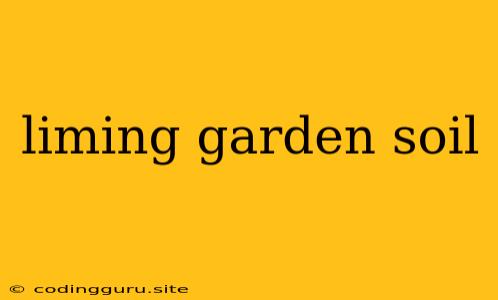Liming Garden Soil: Why, When, and How
A healthy garden begins with healthy soil. While soil is made up of many components, pH plays a crucial role in determining the availability of nutrients for plants. Liming garden soil is an essential practice to ensure your plants thrive by adjusting the soil's pH level.
What is Soil pH?
Soil pH measures the acidity or alkalinity of your soil on a scale from 0 to 14. A pH of 7 is considered neutral, while numbers below 7 indicate acidity and numbers above 7 indicate alkalinity.
Why Lime Your Garden Soil?
Liming garden soil is essential because it helps:
- Increase Soil pH: Most plants prefer a slightly acidic to neutral pH (between 6.0 and 7.0). If your soil is too acidic, adding lime raises the pH level, making nutrients more readily available for your plants.
- Improve Nutrient Availability: Liming helps release essential nutrients like phosphorus, calcium, and magnesium, which are often locked up in acidic soil.
- Enhance Microbial Activity: Lime stimulates the growth of beneficial microorganisms in the soil, improving soil structure and nutrient cycling.
- Reduce Aluminum Toxicity: Aluminum becomes toxic to plants in acidic soils. Liming garden soil helps neutralize the aluminum, making it less harmful.
When Should You Lime Your Garden Soil?
- Testing Your Soil: The first step is to test your soil's pH using a home kit or sending a sample to a laboratory. This will determine the need for liming and the appropriate amount.
- Frequency of Liming: How often you need to lime depends on your soil type, the plants you grow, and your local climate. Generally, soil testing every two to three years is recommended.
- Time of Year: The best time to lime garden soil is in the fall after harvesting or in early spring before planting. This allows the lime to work its way into the soil before the growing season begins.
How to Lime Your Garden Soil
-
Choose the Right Lime: There are different types of lime, each with its own characteristics and benefits. Some common options include:
- Agricultural Lime: A finely ground limestone that provides calcium and raises soil pH.
- Dolomitic Lime: Contains both calcium and magnesium, making it beneficial for soils deficient in magnesium.
- Hydrated Lime: A more potent form of lime used in specific situations where a rapid pH change is needed.
-
Apply the Correct Amount: The amount of lime needed will vary depending on your soil type and the desired pH change. Always follow the instructions on the lime packaging or consult with a soil expert.
-
Spread and Incorporate: Spread the lime evenly across the garden using a spreader or by hand. Incorporate the lime into the soil by tilling or using a garden fork.
-
Water Thoroughly: After applying lime, water the garden thoroughly to help it work its way into the soil.
Tips for Success
- Don't Overdo It: Overliming can be as harmful as underliming, so follow the recommended application rates carefully.
- Avoid Liming Acid-Loving Plants: Some plants, like blueberries and rhododendrons, thrive in acidic soil. Avoid liming around these plants.
- Monitor Your Soil: Regular soil testing is crucial to ensure your lime application is working and adjust as needed.
Conclusion
Liming garden soil is an important practice to ensure your plants have access to the nutrients they need to thrive. By understanding the principles of soil pH and following the guidelines for liming, you can create a healthy and productive garden.
